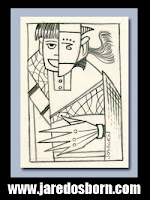
I bought some pastels this week. I have never worked in pastels for more than a few minutes way back in art school. I not sure why I never worked in pastels. Maybe because they were never considered a very manly medium, maybe because they were never really taught at art school (where they were seen as a second rate medium), or maybe because the only ones I ever used were the cheap ones. Cheap pastels are like pieces of hard chalk. Half of the stick turns to dust and falls off of your paper as you grind away. They are really tough to work with. You can do something with cheap paint, cheap pencils, cheap brushes, or even cheap crayons. But cheap pastels are a frustrating nightmare. Sometimes I wonder why they exist.
I bought the pastels because I was inspired by a book that I saw in a catalogue. I didn’t actually get the book but the title was something about using pastels as intense color. There was a simplicity to the cover drawing that I liked. That little one inch high drawing made me think about pastels in a different way. Not that I had ever thought about them much at all.
The famous Impressionist Edgar Degas is the one who put pastels on the map. He’s the only famous artist I know who worked extensively in pastels. Everyone I knew who was into pastels (back in art school) was inspired by Degas. Pastels pretty much begin and end with ol’ Edgar. That little book cover made me see them differently. So I went out and got a cheap set of pastels. Ha! You’d think I’d know better.
By cheap I mean about twelve bucks for ten sticks or so. Some of the colors were okay but the red was like rubbing marble on the paper. I managed to get a couple of things done but it was a struggle. So I ordered an expensive set from the internet. By expensive I mean thirty bucks for fifteen sticks. The full retail is fifty bucks but I got them at a discount art supply web site. Fifty is a little too rich for my blood but thirty was alright. These pastels are softer and a lot more of the pigment sticks to the paper. I like them so far. I haven’t gotten to really delve into what I want to do with them yet but they’ve got me thinking.
Pastels are a lot messier than I thought they would be. Being an oil painter I’m used to messy stuff but pastels are different. A lot of pastel dust drops off as you are drawing and gets on stuff. It can get everywhere. An you can’t just brush it off because it’s supposed to stick to paper so it sticks to skin, clothing, and furniture pretty well. I find myself rinsing my hands quite a bit.
An interesting thing about pastel paper. Back at art school every pastel artist I knew (there were maybe four of them) was always looking for a good pastel paper that gripped the pigment and mad things easier. All kinds of paper were used including a special pastel paper that was akin to sandpaper. It was expensive stuff. I mention this because a few years later I was reading an article on Degas and it mentioned that he drew with his pastels on tracing paper. That cracked me up. All the time, effort , and money that went into finding great paper and everybody’s pastel hero used cheap old tracing paper. Still makes me giggle.
One final thing. The colors you get with pastels aren’t particularly “pastel”. Usually when you hear the word “pastel” it describes colors used by decorators or some such. It’s generally a light version of blue, pink, green, or whatever. The reference comes from the fact that in pastels the pigment is mixed with white clay, chalk, or something along those lines. So pastel colors all have a little white in them. But not nearly as much as in “pastel colors”. Just another small observation for ya.
Discussion ¬